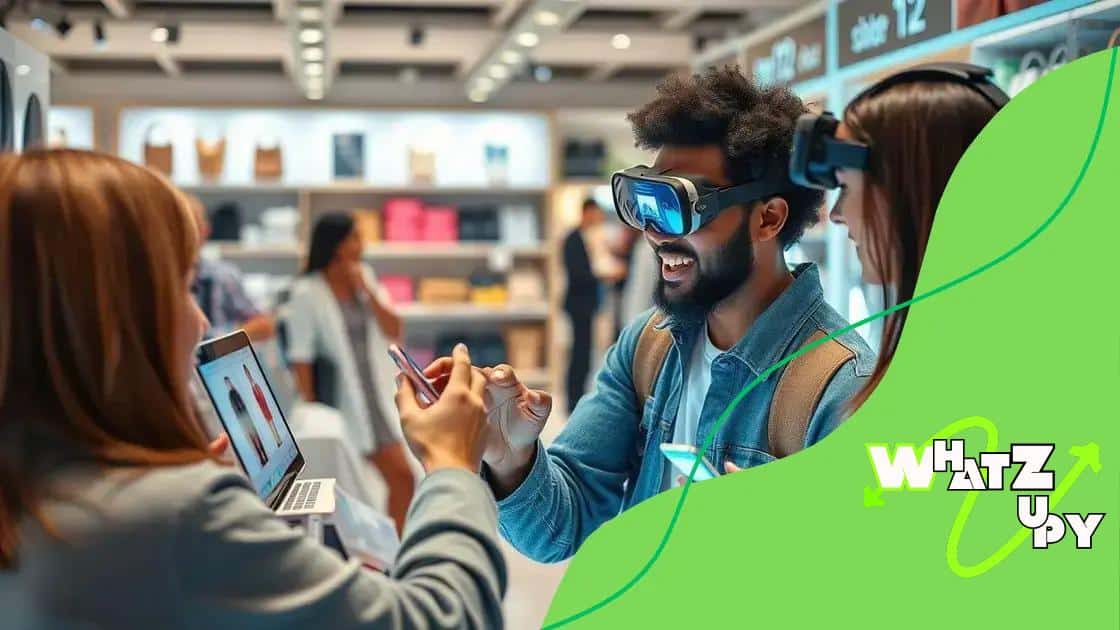Augmented reality’s impact on purchase confidence

Augmented reality’s impact on purchase confidence significantly enhances the shopping experience by allowing customers to visualize products in real-time, leading to increased engagement, better decision-making, and reduced returns.
Augmented reality’s impact on purchase confidence is a game-changer for today’s shoppers. Have you ever wondered how virtual try-ons or interactive displays affect your buying decisions? Let’s dive into this fascinating topic!
Understanding augmented reality in retail
Understanding augmented reality in retail is essential in today’s digital marketplace. Retailers are increasingly adopting this technology to enhance customer engagement and streamline the shopping experience.
The Basics of Augmented Reality
Augmented reality overlays digital information onto the real world. This can include images, sounds, or other data that enhance how customers interact with products. By merging the physical and digital realms, AR transforms traditional shopping.
Benefits for Retailers
Adopting augmented reality in retail brings numerous advantages. Here are some key benefits:
- Improved customer experience: Shoppers can visualize products in their space, leading to better-informed purchasing decisions.
- Increased engagement: Interactive AR experiences captivate customers, encouraging them to spend more time exploring products.
- Competitive advantage: Brands utilizing AR can differentiate themselves in a crowded market, attracting tech-savvy consumers.
Another aspect of augmented reality is its ability to drive impulse purchases. When customers can see how a product fits into their lives, they are more likely to make a quick buying decision. For example, virtual try-ons for clothing or makeup allow shoppers to experiment without the hassle of returns.
Furthermore, AR can provide instant information. A customer scanning a product with their smartphone can access details about features, pricing, and customer reviews, all enhancing the buying experience.
As technology evolves, retail is set to become even more interactive. Future developments in augmented reality might include more personalized shopping experiences tailored to individual preferences. Retailers should keep an eye on trends to capitalize on these innovations.
How AR enhances the shopping experience
How AR enhances the shopping experience is a crucial topic for both retailers and customers. This technology makes shopping more interactive and personalized, which can lead to increased customer satisfaction.
Interactive Product Visualization
With augmented reality, customers can see products in real time in their own environment. For example, using AR apps, shoppers can visualize how a piece of furniture fits in their living room before buying it.
Enhancing Decision-Making
Shoppers often face uncertainty when making decisions. AR helps to ease this uncertainty by providing detailed information right at their fingertips. By scanning a product in a store, they can view features, pricing, and user reviews.
- Try-On Features: Customers can virtually try on clothes or accessories. This feature makes it easier to choose the right fitting items.
- Color and Style Choices: AR allows customers to see different colors and styles without needing physical samples.
- In-Store Promotions: Customers can get special offers when they interact with products via AR.
As AR technology continues to improve, the shopping experience will only become more engaging. Retailers can introduce gamification elements, allowing customers to earn rewards or discounts through interactive shopping experiences.
The convenience offered by augmented reality leads to higher conversion rates. When customers can visualize a product’s fit and use before purchase, they’re more likely to complete their transactions.
By integrating AR into the shopping experience, retailers can create a strong connection with customers, leading to loyalty and repeat business. The future of shopping looks bright as technology paves the way for richer and more satisfying consumer interactions.
Impact of AR on consumer behavior

The impact of AR on consumer behavior is significant and multifaceted. As augmented reality technology becomes more prevalent, it changes how consumers interact with products and make purchasing decisions.
Increased Engagement
One major way AR affects consumer behavior is by enhancing engagement. When shoppers can interact with a product digitally, they tend to spend more time exploring their options. This deeper interaction can lead to a stronger emotional connection to the product.
Boosting Confidence in Purchases
AR also helps boost confidence in purchasing decisions. By allowing customers to visualize how a product fits into their lives, whether it’s a piece of furniture or clothing, they are more likely to feel certain about their choices. When shoppers can try things on virtually or see how items fit in their space, they are more likely to proceed with the purchase.
- Enhanced Product Understanding: Customers can see items from different angles, which leads to better understanding of product features.
- Lower Returns: With AR, customers make informed choices, reducing the likelihood of returns.
- Personalized Experiences: AR can customize experiences based on user preferences, making shopping more relevant and satisfying.
The influence of AR on impulse buying is also noteworthy. Retailers use AR to create captivating experiences that can trigger quick buying decisions. For instance, limited-time offers through AR can encourage immediate purchases. The thrill of engaging with a product in an immersive way can override hesitation.
Moreover, social sharing of augmented experiences can amplify the reach of a brand. Customers enjoying their AR experiences are likely to share them on social media, attracting new prospects through word-of-mouth and visual appeal. This kind of organic marketing is powerful as it taps into consumer trust and community engagement.
Case studies: AR success stories
Case studies of AR success stories illustrate how businesses leverage augmented reality to enhance customer experiences and drive sales. Various industries have adopted this technology with remarkable results, making their case a valuable learning tool.
1. IKEA Place
IKEA introduced the IKEA Place app, allowing customers to visualize furniture in their homes before purchasing. Users can see how a sofa looks in their living room or how a table fits in their dining area. This not only helps with decision-making but also improves customer satisfaction.
2. L’Oreal Makeup Genius
L’Oreal launched the Makeup Genius app, which uses AR to let users try on cosmetics virtually. Customers can experiment with different shades of lipstick or eyeshadow in real time. This interactivity has led to increased conversion rates as users feel more confident in their purchases.
- Key Features of Makeup Genius:
- Instant visual feedback on makeup products.
- Personalized recommendations based on user preferences.
- Easy sharing options on social media.
These applications have shown how AR not only improves the buying experience but also creates engaging marketing opportunities. Another compelling example is the use of AR by Adidas. The company implemented an AR campaign for a new shoe launch. Customers who scanned posters in stores could see a virtual version of the shoes in action, enhancing brand engagement.
This kind of experience captures attention and provides unique interactions that traditional marketing cannot achieve. Retailers are finding that AR can help tell their brand story in an immersive way. By creating memorable experiences, brands can foster customer loyalty and encourage repeat business.
As AR technology advances, it will continue to present exciting opportunities. Cases like these demonstrate the potential for businesses to disrupt their industries and create stronger connections with consumers.
Future trends in AR technology
Future trends in AR technology promise to reshape the way we interact with the world around us. As advancements continue to emerge, we can expect even more innovative applications that enhance both shopping and everyday experiences.
1. Enhanced Personalization
One major trend is the move towards greater personalization. Future AR applications will use data to tailor experiences for each user. This means that customers will see product recommendations based on their browsing habits and preferences. With the help of artificial intelligence, AR can learn from user interactions, making each experience more relevant.
2. Integration with Artificial Intelligence
The integration of AR with artificial intelligence (AI) will enhance interactivity. For example, AI chatbots could guide users through AR environments, offering on-the-spot assistance while they shop. This technology will create a smoother user experience, making it easier for customers to find and purchase products.
- Interactive virtual guides: Customers can receive real-time information through AR.
- Smart fitting rooms: Retailers may implement AR mirrors that suggest items based on style preferences.
- Enhanced visual search: Users could simply point their device at an item and get details.
Another exciting trend is the increased use of AR in social media. Platforms will continue to integrate AR filters, enhancing user engagement by allowing individuals to interact with brands in innovative ways. This could lead to more interactive advertisements and promotional content that captivates viewers.
Moreover, the rise of 5G technology will significantly improve AR experiences. With faster internet speeds, AR applications will become more responsive and sophisticated. This will allow for real-time interactivity, enabling customers to experience AR without lag or delays.
As remote shopping becomes more popular, AR technology will offer consumers the chance to have a more immersive experience. Customers may attend virtual showrooms or view products through AR-enhanced platforms, making online shopping feel as engaging as an in-store experience.
In conclusion, augmented reality is transforming how we shop and interact with products. As AR technology continues to advance, we can expect to see more personalized experiences that enhance customer engagement and boost sales. Retailers are realizing the benefits of implementing AR in various ways, including virtual try-ons and interactive product displays. These innovations create a more convenient and immersive shopping experience, which leads to greater consumer confidence and satisfaction. Looking ahead, the future trends in AR promise even more exciting developments that will redefine the retail landscape.
FAQ – Frequently Asked Questions about Augmented Reality in Retail
How does augmented reality enhance the shopping experience?
Augmented reality allows customers to visualize products in their own space, improving engagement and confidence in purchasing decisions.
Can AR technology help reduce product returns?
Yes, by allowing customers to see how products fit their needs before buying, AR can help minimize mismatches and reduce the likelihood of returns.
What are some examples of successful AR implementations in retail?
Notable examples include IKEA’s Place app for visualizing furniture and L’Oreal’s Makeup Genius app for trying on cosmetics virtually.
What future trends can we anticipate in AR technology?
Future trends in AR may include greater personalization, integration with AI, and enhanced user experiences through faster internet connectivity.





